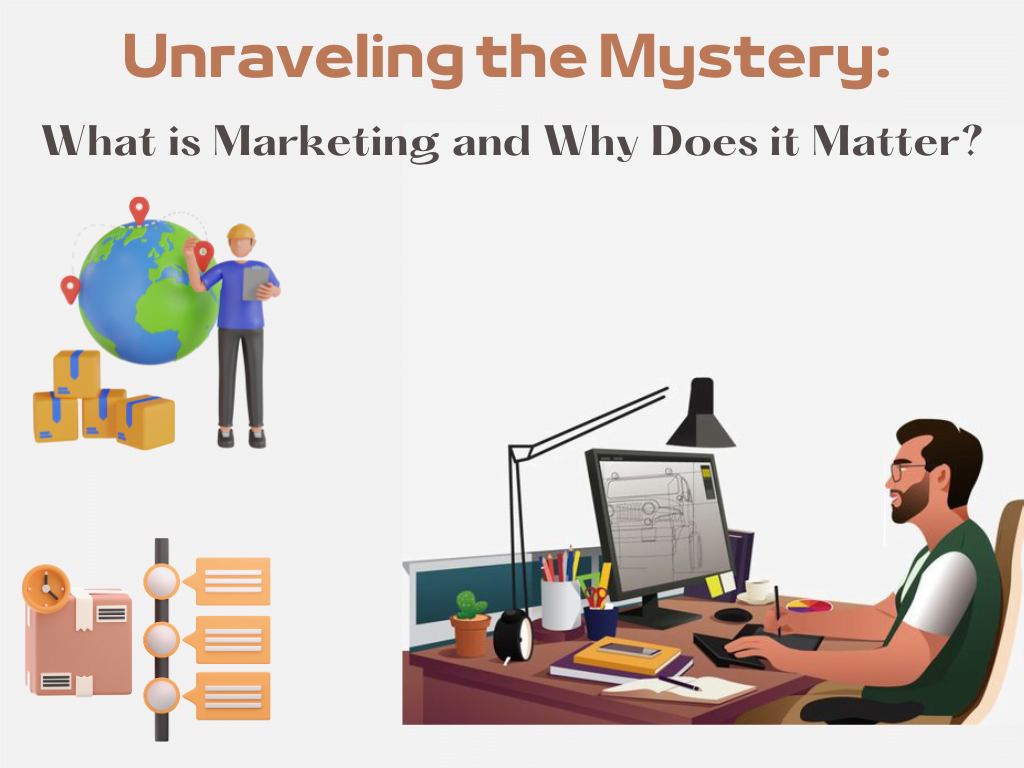
Unraveling the Mystery: What is Marketing and Why Does it Matter?
A blog post exploring the fundamental concepts of marketing and its significance in today’s business landscape.
Marketing is often seen as a mysterious and complex concept, but in reality, it is the heartbeat of any successful business. Understanding the fundamental principles of marketing is crucial for reaching customers, building brand awareness, and driving sales in today’s competitive business landscape. In this blog post, we will unravel the mystery behind marketing, exploring its definition, key components, and why it holds such importance for businesses of all sizes. Join us on this journey to discover the power of marketing and why it truly matters in the world of commerce.
Demystifying Marketing: The Core Concepts
Marketing is a multifaceted discipline that plays a pivotal role in the success of businesses across various industries. Marketing is about understanding customer needs, creating value propositions, and effectively communicating messages to target audiences. By demystifying marketing and grasping its fundamental concepts, businesses can strategically position themselves in the market, differentiate their offerings, and ultimately drive customer engagement and loyalty. One key concept in marketing is segmentation, targeting, and positioning (STP).
What is Marketing? (Definition & Goals)
Marketing plays a pivotal role in the success of any business. It encompasses a wide array of strategies and activities designed to promote, sell, and distribute products or services to target customers. At its core, marketing is all about creating value for customers and building strong relationships that lead to brand loyalty and repeat business.
Definition of Marketing:
Marketing can be defined as the process of profitably identifying, anticipating, and satisfying customer needs and wants. It involves understanding consumer behavior, conducting market research, developing products or services that meet customer demands, and effectively communicating the value proposition to the target audience.
Goals of Marketing:
The primary goals of marketing are to attract, engage, and retain customers while driving profitable sales and revenue growth for the business. By establishing a strong brand presence, creating compelling marketing campaigns, and delivering exceptional customer experiences, companies can differentiate themselves from competitors and build a loyal customer base.
Marketing Strategy:
A well-defined marketing strategy is essential for achieving business objectives and maximizing the impact of marketing efforts. It involves setting clear goals, defining target markets, identifying competitive advantages, and selecting the most effective channels and tactics to reach and engage customers. A strong marketing strategy aligns with the overall business goals and drives sustainable growth and success. In today’s fast-paced and competitive business landscape, having a solid understanding of marketing principles and implementing effective marketing strategies is essential for businesses to stand out, connect with customers, and drive long-term success.
By unraveling the mystery behind marketing and embracing its power, companies can unlock new growth opportunities and create lasting value in the marketplace.
5 Ways Logistics Marketing Can Revolutionize Your Supply Chain: From Cost Savings to Customer Delight
In today’s e-commerce-driven world, customers expect fast, reliable, and transparent deliveries. Logistics, once seen as a purely operational function, has become a strategic differentiator. Logistics marketing goes beyond simply moving goods from point A to B. It’s about crafting a narrative that showcases the efficiency, transparency, and customer-centricity of your supply chain. Here are five ways innovative logistics marketing can revolutionize your business:
1- Transparency Builds Trust:
Customers crave real-time updates on their orders. Logistics marketing can leverage technology to provide shipment tracking, estimated delivery windows, and proactive notifications of any delays. Imagine a customer receiving a personalized email with a map showing their order’s exact location and estimated arrival time. This transparency builds trust and reduces customer service inquiries, freeing up resources for other areas.
2- Content Creates Value:
Logistics marketing isn’t just about selling; it’s about educating. Create informative content that showcases your expertise. This could include blog posts on optimizing packaging for sustainability, infographics detailing your global reach, or even behind-the-scenes videos showcasing the technology powering your efficient deliveries. By establishing yourself as a thought leader, you not only attract new customers but also build stronger relationships with existing ones.
3- Omnichannel Communication:
Today’s customers expect seamless interaction across different channels. Logistics marketing should reflect this. Develop an omnichannel strategy that integrates your website, social media platforms, and email marketing. Provide consistent messaging about your delivery options, sustainability efforts, and any special promotions related to shipping. This creates a unified brand experience and keeps customers informed throughout their journey.
4- Partnerships for Growth:
Collaboration is key in the complex world of logistics. Partner with other businesses to offer customers a wider range of delivery options and value-added services. This could involve collaborating with local couriers for faster last-mile deliveries or partnering with eco-friendly packaging companies to showcase your commitment to sustainability. By leveraging strategic partnerships, you can expand your reach and enhance your service offerings.
5- Data-Driven Decisions:
Logistics is awash with data. Logistics marketing utilizes this data to optimize operations and personalize the customer experience. Analyze delivery times, identify customer preferences, and leverage insights to tailor your marketing efforts. For instance, you could offer express shipping options to frequent customers or highlight faster delivery times for specific regions. By using data strategically, you can streamline your operations, reduce costs, and delight your customers.
In conclusion, logistics marketing is no longer an afterthought. It’s a powerful tool that can revolutionize your supply chain by building trust, creating value, and delivering a customer-centric experience. By implementing these five strategies, you can transform your logistics function from a cost center to a strategic advantage, ultimately driving growth and customer satisfaction.
The 4 P's of Marketing (Product, Price, Place, Promotion)
In the realm of marketing, the concept of the 4 P’s holds significant importance as it forms the foundation of any successful marketing strategy. These four elements – Product, Price, Place, and Promotion – collectively make up the marketing mix, guiding businesses in crafting effective campaigns and engaging with their target audience.
Add Your Heading Text Here
1. Product
At the core of any marketing strategy lies the product or service being offered. Understanding the unique features, benefits, and valu messaging and branding to showcase the product’s strengths and address the needs of their target customers.
2. Price
Determining the right pricing strategy is crucial for achieving a balance between profitability and customer satisfaction. Pricing decisions should take into account factors such as production costs, competition, perceived value, and pricing elasticity. By conducting thorough market research and analysis, businesses can set prices that are competitive and appealing to their target market.
3. Place
The ‘Place’ element of the marketing mix focuses on distribution channels and the physical or digital locations where customers can access the product. Whether through retail stores, e-commerce platforms, or other channels, businesses must ensure that their products are readily available to customers when and where they need them. Effective placement strategies can enhance accessibility and convenience, driving customer satisfaction and loyalty.
4. Promotion
Promotion encompasses the various tactics and activities used to communicate with customers and generate interest in the product. This includes advertising, public relations, sales promotions, and other marketing communications efforts. By crafting compelling messages and leveraging appropriate channels, businesses can create awareness, drive engagement, and ultimately, stimulate purchasing behavior. Understanding and effectively applying the 4 P’s of marketing is essential for businesses looking to create impactful marketing campaigns, optimize their marketing mix, and achieve their strategic objectives. By carefully considering each element and how they interact with one another, businesses can develop comprehensive marketing strategies that resonate with their target audience and drive success in today’s competitive business landscape.
Why Marketing Matters in the Digital Age
Marketing has always been a vital aspect of business success, but in the digital age, its significance has reached new heights. With the rapid evolution of technology and the proliferation of online platforms, businesses now have unprecedented opportunities to connect with their target audiences in more personalized and impactful ways. In today’s digital landscape, marketing plays a crucial role in helping businesses stand out in a crowded marketplace, engage with customers on a deeper level, and drive meaningful interactions that lead to conversions and brand loyalty. Moreover, the digital age has shifted consumer behavior, with more people turning to the internet to research products, make purchasing decisions, and interact with brands.
As a result, businesses that leverage digital marketing strategies effectively can reach a wider audience, target specific demographics with precision, and track the performance of their campaigns in real-time. This data-driven marketing approach allows businesses to optimize their strategies, refine their messaging, and deliver more relevant and engaging content to their target customers.
Gone are the days of relying solely on flyers and billboards. Today’s marketing requires a strategic, data-driven approach to reach the right audience, build lasting relationships, and achieve success. This section will delve into the key reasons why marketing:
Building Brand Awareness and Customer Loyalty
Building Brand Awareness and Customer Loyalty are two key pillars of successful marketing strategies. Establishing a strong brand presence in the market can significantly impact consumer perceptions and purchasing decisions. By consistently delivering a compelling brand message through various channels, you can increase recognition, trust, and loyalty among your customers. Customer loyalty, on the other hand, is the holy grail of marketing. It involves cultivating a strong bond with your customers, ensuring repeat business and positive word-of-mouth recommendations. Loyal customers not only generate recurring revenue but also serve as brand advocates, influencing others to choose your products or services. To build brand awareness and customer loyalty effectively, businesses must prioritize delivering exceptional customer experiences, maintaining consistent branding across all touchpoints, and engaging with their target audience through personalized interactions. By investing in these aspects of marketing, companies can forge long-lasting relationships with customers and differentiate themselves in the competitive market landscape.
Reaching Your Target Audience Through Effective Strategies
Reaching Your Target Audience Through Effective Strategies One of the core aspects of marketing is effectively reaching your target audience. To successfully connect with potential customers, businesses must employ strategic methods that resonate with their specific demographic. Understanding your target audience’s preferences, behaviors, and needs is essential in crafting tailored marketing strategies that will capture their attention and drive engagement. Utilizing market research, data analytics, and customer insights, businesses can gain valuable information that guides the development of targeted campaigns. By segmenting your audience based on demographics, psychographics, or behavioral characteristics, you can create personalized messages that speak directly to their interests and motivations. Furthermore, leveraging various marketing channels such as social media, email marketing, content marketing, and search engine optimization allows businesses to engage with their audience across multiple touchpoints. By establishing a cohesive and consistent brand presence across these channels, businesses can strengthen their relationship with customers and cultivate brand loyalty. In today’s fast-paced digital landscape, adapting to emerging trends and technologies is key to staying relevant and reaching your target audience effectively. By continuously evaluating and refining your marketing strategies based on consumer feedback and market dynamics, you can optimize your efforts to connect with your audience and drive meaningful results for your business.
Measuring Marketing Success with Data and Analytics
Measuring Marketing Success with Data and Analytics One of the key aspects of marketing in today’s digital age is the ability to measure success using data and analytics. Gone are the days of solely relying on intuition and guesswork to evaluate marketing campaigns. By utilizing data-driven insights, businesses can make informed decisions, optimize strategies, and drive results more effectively. Data and analytics provide valuable metrics that enable marketers to track the performance of their campaigns, understand customer behavior, and identify areas for improvement. From website traffic and social media engagement to conversion rates and return on investment, data offers a comprehensive view of marketing effectiveness. By analyzing this data, businesses can gain valuable insights into what is working well and what may need adjustment. This allows marketers to refine their tactics, target their efforts more efficiently, and ultimately achieve greater success in reaching their marketing goals. In today’s competitive business landscape, the ability to measure marketing success with data and analytics is essential for staying ahead of the curve and maximizing the impact of marketing efforts. By harnessing the power of data-driven insights, businesses can drive growth, build customer loyalty, and ultimately thrive in an ever-evolving marketplace.
Conclusion
In conclusion, marketing plays a pivotal role in the success of businesses, serving as the heartbeat that drives customer engagement, brand visibility, and ultimately, sales growth. By unraveling the mystery behind marketing in this blog post, we have explored its fundamental concepts and shed light on its significance in today’s dynamic business environment. Armed with a deeper understanding of marketing’s key components and importance, businesses of all sizes can harness its power to stand out in a competitive marketplace and build lasting connections with their target audience. Embrace the power of marketing and watch your business thrive in the ever-evolving world of commerce.





